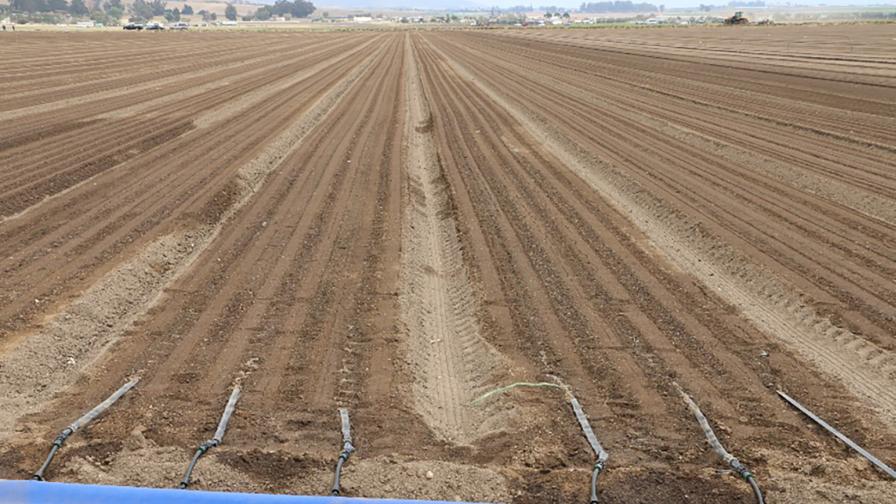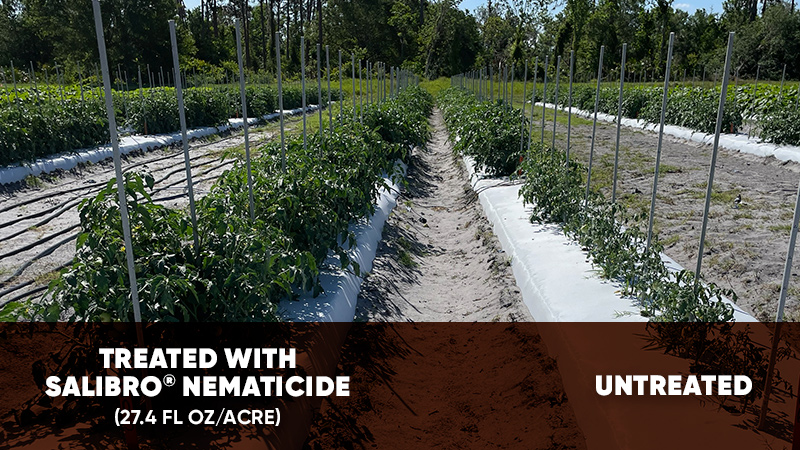Drip Irrigation Capability on the Rise for Vegetable Growers

Single-use drip tape is injected a few inches below the soil surface so that it can be used to germinate up lettuce.
Photo by Michael Cahn
Drip irrigation always seems to be evolving in the Salinas Valley. For many years, growers reused surfaced-placed drip tape they retrieved and repaired after the crop is harvested. Typically, surface drip is used after the crop has been germinated with sprinklers and cultivated.
More recently a new method of using drip has been catching on. “Before planting, growers bury drip tape deeply enough to allow planting and cultivation without puncturing the tape. But it needs to be high enough to allow germination and crop establishment, eliminating the need for sprinklers.
Once the crop is harvested, the shallowly buried tape can be removed. But rather than winding it carefully onto spools so it can be reused, the tape is rolled tightly into large bundles that can be hauled to a recycling facility.
A specialized machine was developed to simultaneously bundle tape from eight or more beds together, which saves on labor. Since the tape is recycled rather than reused, this also saves on the labor needed to repair damaged tape. Thin-walled tape is also less expensive than the durable, thick-walled product, which is needed when reusing tape for multiple crops.
Because new tape is installed for every crop, leaks are rare, and the application uniformity of the drip systems can potentially be very high. Drip also helps growers address some common problems with germinating lettuce with overhead sprinklers, such as wind patterns, soil crusts that reduce emergence, and runoff.
Despite all of the economic and agronomic benefits of single-use drip tape, growers have experienced difficulties in learning to use this new technology. One of the biggest challenges is achieving uniform germination. If the tape is buried too deep or not placed equidistant between seedlines, it can be difficult to wick moisture laterally to wet up the seeds, which are planted only ¼-inch deep. Often, extra water must be applied to assure that seed in a small area of a field has sufficient moisture.

Single-use drip can be retrieved from fields after harvest using a specialized machine and coiled into large bundles that are ready for recycling.
Photo by Michael Cahn
Soil Type Makes a Difference
A study we recently finished concluded that on some fields, growers applied more than twice as much water by drip than by sprinklers to germinate seeded lettuce.
After comparing water use for germination between drip and sprinklers in seven lettuce fields, we determined that on average, growers were not saving water by using drip to germinate their crops. However, we also identified several key reasons why irrigators were often struggling to get good germination with drip.
Besides the placement of the tape, soil type was a key factor. Fields with clay soil that formed coarse aggregates were not good candidates for drip germination. Since moisture wicks best through small soil pores, loam and sandy loam-textured soils with tightly packed, small aggregates were better suited for germinating crops with drip.
Soil preparation was also important in achieving seed beds with fine aggregate structure to optimize lateral movement of moisture as well as seed placement.
We also observed that uniformity of the drip systems was often poor despite using new tape because the pressure at the submain was low (< 5 psi), and often the length of the drip lines was very long (>1000 feet). In fields where we experimented with increasing the submain pressure to 10 psi and splitting long fields so that drip lines were less than 600 feet in length, we were able to demonstrate much better germination using low amounts of water.
In conclusion, the use of drip has steadily increased in the Salinas Valley over the years as new innovations have improved the economics of this technology, resulting in better crops using less labor. However, trained staff who understand how to trouble-shoot and optimize irrigation systems will
be essential for taking advantage of all the water savings potential of drip.










